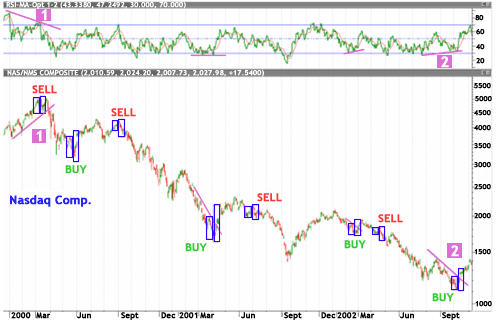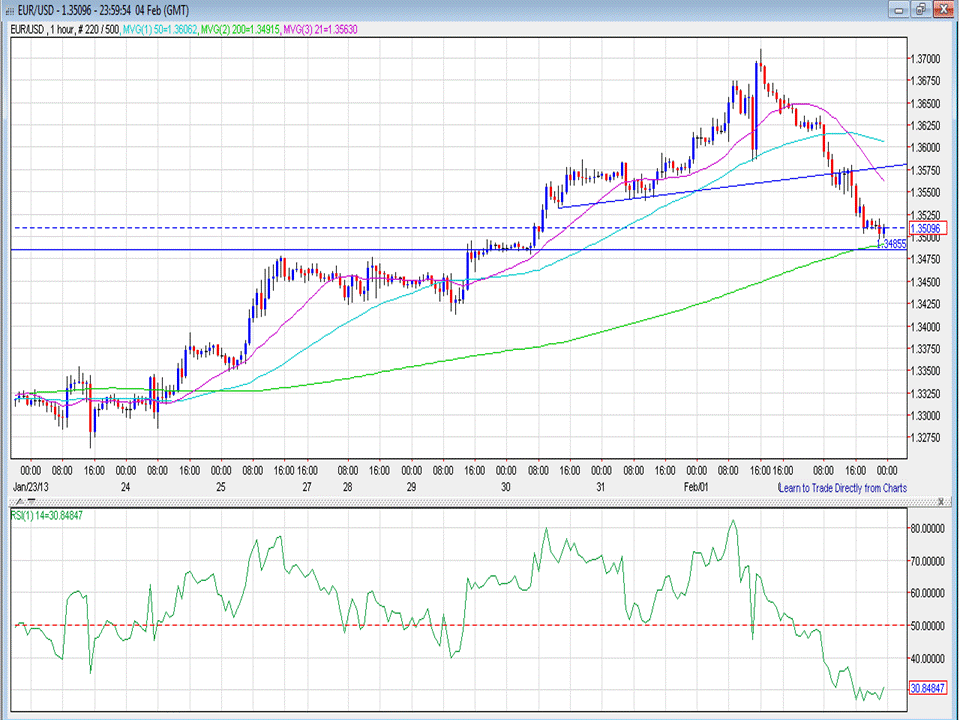Bulkowski s RSI Trading Setups
Post on: 16 Март, 2015 No Comment

RSI Trading Setups: Introduction
The Wilder relative strength index (RSI) is a price momentum indicator that is useful for intraday trading. Values above 70 mean price is nearing a top or correction of the uptrend. Values below 30 mean price is nearing a bottom or retrace of the decline. The RSI’s primary value is calling the turning points in a trading range market (between support and resistance).
As an overbought, oversold indicator, it works 75% of the time, but it says nothing about how far price will travel. As a divergence indicator, where the indicator diverges from price and points to a new trend, it proved accurate and timely, working between 76% and 82% of the time.
Here are some trading rules that should help with profitability.
- Buy when the RSI indicator rises above 30 from below, especially if accompanied by high volume (or volume trends upward).
- Sell when the RSI indicator drops below 70 from above, especially if accompanied by high volume (or volume trends upward).
- If RSI is midrange (between 30 and 70), then ignore it, including divergence signals.
- Trade after a straight-line price run and divergence appears with the RSI indicator.

RSI Trading: Overbought and Oversold Signals
Here are the trading rules for using RSI as an overbought or oversold indicator. These assume a 14-period look back on the RSI and a 10-day intraday price chart.
- If you have access to tools that you can change the 14-period look back, try tuning it for your market. Locate regions of support and resistance and see if changing the 14-period look back to another value will give you better turning point prediction. You are looking for signals that help you time the move from support to resistance and back again. Perhaps you want to use different signal lines than 30 and 70 (like 20 and 80). Play with it. See if you can get RSI to signal when it hits or approaches support or resistance zones.
- Find your buy or sell candidate in the usual manner, following rules and procedures you have already setup. Plot the RSI indicator. For example, if you see price topping out, high volume accompanies the turn, and RSI says the stock is overbought, that’s a sell signal.
- If RSI is above 70, then wait for it to drop below 70 before trading. Close out a long trade, go short, or buy a put option. Large price declines often start from the overbought region. High volume can confirm the trend change.
- If RSI is below 30, then wait for it to rise above 30 before trading. Then buy, cover a short, or buy a call option. Large price advances often start from the oversold region. High volume can confirm the trend change.
- If RSI is midrange, then ignore the signal.
RSI Trading: Divergence
Looking at your charts, it may be unclear whether you look for divergence along the price peaks or valleys. Here’s a system that works.
- If the price trend is down, use the bottoms to look for divergence
- If the price trend is up, use the tops to look for divergence.
- If price is moving horizontally (a trading range), then don’t look for divergence, especially if the indicator is between 30 and 70!
Here are the rules for trading on bullish divergence .
- Avoid divergences that occur in the RSI neutral zone (between 30 and 70). Price will follow the indicator, but the move may or may not be significant.
- If price is moving down, then look for divergence along the price and indicator lows not the highs.
- Look for a straight-line run down
- The indicator should bottom near or below 30.
- If bullish divergence occurs, that’s the buy signal.
- If volume is trending higher or spikes higher, that helps confirm the buy signal.
- If the indicator makes a new low, then close out the trade (failed bullish divergence signal).
Here are the bearish divergence trading rules. They are similar to the bullish divergence rules.
- Avoid divergences that occur in the RSI neutral zone (between 30 and 70). Price will follow the indicator, but the move may or may not be significant.
- If price is moving up, then look for divergence along the price and indicator peaks not the valleys.
- Look for a straight-line run up to show upward momentum.
- The indicator should top out near or above 70.
- If bearish divergence occurs, that’s the sell signal.
- If volume is trending higher or spikes higher, that helps confirm the sell signal.
- Confirm with a trend following indicator that the trend has indeed changed.
- If the RSI indicator makes a new high, then close out the trade (failed bearish divergence signal).














